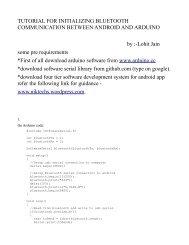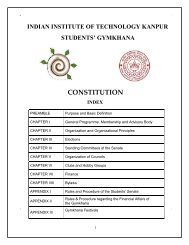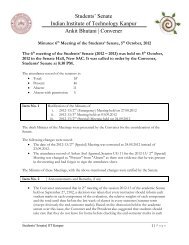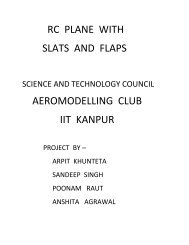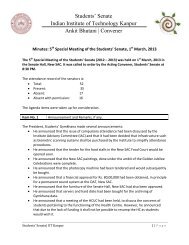new ENERGY AUDIT OF IIT KANPUR HOSTEL AREA-1
new ENERGY AUDIT OF IIT KANPUR HOSTEL AREA-1
new ENERGY AUDIT OF IIT KANPUR HOSTEL AREA-1
Create successful ePaper yourself
Turn your PDF publications into a flip-book with our unique Google optimized e-Paper software.
Project Samadhan<br />
The Group for Environment and Energy Engineering<br />
<strong>IIT</strong> Kanpur Halls of Residence energy audit<br />
Project Samadhan<br />
Group of Environment and Energy Engineering<br />
The Group for Environment and Energy Engineering 1
Project Samadhan<br />
Samadhan Team<br />
Students<br />
Anand Vardhan Mishra<br />
Shyam Panjwani<br />
Rahul Singh<br />
Akshit S<br />
Mayank Bansal<br />
Neetisha Besra<br />
Shashank Tripathi<br />
Faculty and Mentors<br />
Dr. S.S.K. Iyer<br />
Institute Works Department<br />
Mr. Rajeev Garg<br />
Mr. Pankaj Singh<br />
Mr. Raghvendra Singh<br />
ABSTRACT<br />
The following report has been prepared with a view to facilitate our<br />
understanding of the energy consumption pattern of the Halls of Residence of <strong>IIT</strong><br />
Kanpur. The report focuses on energy efficiency measures.<br />
The Group for Environment and Energy Engineering 2
Project Samadhan<br />
Preface<br />
An energy audit is a study of a plant or facility to determine how and where<br />
energy is used and to identify methods for energy savings. There is now a<br />
universal recognition of the fact that <strong>new</strong> technologies and much greater use of<br />
some that already exist provide the most hopeful prospects for the future. The<br />
opportunities lie in the use of existing re<strong>new</strong>able energy technologies, greater<br />
efforts at energy efficiency and the dissemination of these technologies and<br />
options.<br />
This energy audit of the <strong>IIT</strong>-K Hostels area was carried out by the members of<br />
the GE3.This report is just one step, a mere mile marker towards our destination<br />
of achieving energy efficiency and we would like to emphasise that an energy<br />
audit is a continuous process. We have compiled a list of possible actions to<br />
conserve and efficiently utilize our scarce resources and identified their savings<br />
potential. The next step would be to prioritize their implementation.<br />
We look forward with optimism that the institute authorities, staff and students<br />
shall ensure the maximum execution of the recommendations and the success of<br />
this work.<br />
The Group for Environment and Energy Engineering 3
TABLE <strong>OF</strong> CONTENTS<br />
Project Samadhan<br />
List of figures<br />
List of tables<br />
1. Introduction<br />
1.1 Objective of the energy audit<br />
1.2 <strong>IIT</strong> present energy scenario<br />
2. Energy Audit<br />
2.1 Methodology<br />
2.2 Grouping and strategy<br />
3. Quantification by end use<br />
3.1 Hostels Rooms<br />
3.2 Water pumping<br />
3.3 Energy consumption in hostel kitchens<br />
4. Measurements performed in hostels<br />
4.1 Room air conditioners<br />
4.2 Lighting and fan loads<br />
5. Benchmarking<br />
5.1 Energy performance of various Hostels<br />
5.2 Per unit area energy consumption<br />
5.3 Per capita energy consumption<br />
5.4 Per capita electrical energy consumption in hostels<br />
5.5 ECBC standards and comparison<br />
6. Energy conservation and efficiency<br />
6.1 Implementation measures<br />
6.2 Energy management structure<br />
Appendix A – Wing-wise comparative energy consumption graphs.<br />
Appendix B – Hostel wise comparative energy consumption graph.<br />
Appendix C – References<br />
Acknowledgements<br />
The Group for Environment and Energy Engineering 4
Project Samadhan<br />
LIST <strong>OF</strong> FIGURES<br />
Fig 3.1: Connected Load Distribution (In kW)<br />
Fig 4.1: AC Load for a day without energy saver for AC’s<br />
Fig 4.2: AC Load for a day with energy saver for AC’s<br />
Fig 5.1: Total Annual Energy Consumption for Different Hostels In 2007<br />
Fig 5.2: Per unit area energy consumption (kWh/sq.m/year) for Hostels<br />
Fig 5.3: Per capita electrical energy consumption (kWh/person/yr.) for hostels<br />
The Group for Environment and Energy Engineering 5
LIST <strong>OF</strong> TABLES<br />
Project Samadhan<br />
Table 3.1: Lighting and Fan Load in Hostels<br />
Table 3.2: Details of energy consumption and food wastage in hostel kitchens<br />
Table 4.1: Energy savings achieved by installation of energy saver for 1.5 ton AC<br />
Table 4.2: Measurement for lighting in Hostels<br />
Table 4.3: Luxmeter Reading of Hostels<br />
Table 5.1: Standard illuminance Levels for different Purposes<br />
The Group for Environment and Energy Engineering 6
Introduction<br />
Project Samadhan<br />
This Project is the vision to make <strong>IIT</strong> Kanpur hostels energy efficient . It is a fact<br />
that Hostels of <strong>IIT</strong> Kanpur community uses a huge amount of energy and it is<br />
also very obvious that we waste quite a sizable chunk of it.<br />
<strong>IIT</strong> Kanpur’s energy bill keeps up around INR 9-10 crore per year. This amount is<br />
huge and thus naturally attracts attention when we understand that quite a lot of<br />
energy is being wasted, which in turn would mean that huge amount of financial<br />
resources are being wasted.<br />
Making the Hostel area energy efficient will not only help the institute reduce its<br />
expenses but also helps us fulfil our moral responsibility of not wasting this<br />
precious resource, which is scarcely available to rest of the people of the country.<br />
This would act as a prototype project, the lessons learnt here can be put to<br />
practice in the future as we progress and move to other parts of the campus.<br />
Hostels have been chosen because they are quite familiar to us, are very<br />
accessible and have conspicuous energy wastage that can be reduced.<br />
We are confident that the results that will come out of this exercise are bound to<br />
be of interest to everyone and can be the first step to make <strong>IIT</strong> Kanpur<br />
energetically the most efficient campus in India.<br />
1.1 Energy Audit Objective<br />
Primary:<br />
The First objective is to acquire and analyze data and finding the energy<br />
consumption pattern of these facilities.<br />
The second objective will be to calculate the wastage pattern based on the<br />
results of the first objective.<br />
The final objective is to find and implement solutions that are acceptable<br />
and feasible<br />
Secondary:<br />
This would be our first exposure to this field hence experience gain would<br />
be vital.<br />
This project will precede many follow up projects and hence help GE3 to<br />
gain technical and management exposure required for future energy<br />
projects<br />
It is sure to help create a repertoire of vital contacts hence will develop<br />
interaction with alumni, faculty and students.<br />
The Group for Environment and Energy Engineering 7
Project Samadhan<br />
It would also increase knowledge among students about streams of study<br />
other than their own which is in the spirit of the interdisciplinary<br />
approach of <strong>IIT</strong> Kanpur.<br />
<strong>IIT</strong> Kanpur Present Energy scene<br />
<strong>IIT</strong> Kanpur has an approximate area of 1150 acres with a student community<br />
strength of around 3800 and about 300 faculty. There is a floating population of<br />
of the order of 1000 in the campus as the Nankari residents enjoy the right of<br />
way through the campus. <strong>IIT</strong> Kanpur enjoys 24 hour electricity supply while<br />
within a few hundred feet of the institute there are 12 hour power cuts.<br />
<strong>IIT</strong> Kanpur has a demand of 8.5 MW (NPC data). Operating power factor hovers<br />
around a good 0.98.<br />
The Specific Energy Consumption (SEC) is defined as the energy consumption<br />
per unit of product output. The specific energy consumption considering<br />
students were calculated which forms the Hostels SEC and was taken as<br />
reference for comparison. The SEC was calculated to be 2252<br />
kWh/person/annum (for 2007-08) for the Hostels.<br />
The Group for Environment and Energy Engineering 8
Project Samadhan<br />
2. Energy audit<br />
2.1 Energy audit methodology<br />
The methodology adopted for this audit was<br />
Formation of audit groups for specific areas and end use<br />
Visual inspection and data collection<br />
Observations on the general condition of the facility and equipment<br />
and quantification<br />
Identification / verification of energy consumption and other<br />
parameters by measurements<br />
Detailed calculations, analyses and assumptions<br />
Validation<br />
Potential energy saving opportunities<br />
Implementation<br />
As a first step in this regard, 4 teams of total 6 students from the group were<br />
formed and each team was assigned a particular area or application of energy in<br />
the campus.<br />
2.2 Grouping and strategy<br />
The following groups were formed with specific target areas and end uses<br />
assigned<br />
Team 1: Lighting , Fans etc. in Hostel 1 to Hostel<br />
Team 2: Lighting, Fans etc. in Hostel 6 to Hostel 9 & GH1<br />
Team 3: Data logging<br />
Team 4: Past Data Collection from IWD (internal Works Department)<br />
The groups were allowed the use of various measuring instruments like Lux<br />
meters to assist in the auditing activity.<br />
The Group for Environment and Energy Engineering 9
3. Quantification by end used<br />
Project Samadhan<br />
The loads were segregated based on the end use as lighting and fans,<br />
Computer/printers, water pumping. Quantification, types and necessary<br />
measurements were carried out. The details are given below:<br />
Figure 3.1:Connected Electrical Load<br />
Distribution(In KW)<br />
38408<br />
51000 LIGHTINGS<br />
FANS<br />
100<br />
47680<br />
AIR-CONDITIONER<br />
COMPUTERS<br />
3.1 Hostels Rooms<br />
3.1.1 Lighting and fans<br />
The Institute has about 7571 Fluorescent tube lights. Hostels are having 4393<br />
fans in different Hostels. The total lighting load from the above is 302 kW and the<br />
connected fan load is 352 kW.<br />
Table 3.1: Lighting and Fan Load in Hostels<br />
<strong>HOSTEL</strong> NO. Of FLOUROSCENT TUBE LIGHTS(40 W) NO. of FANS(80 W)<br />
HALL 1 903 538<br />
HALL 2 936 348<br />
HALL 3 693 339<br />
HALL 4 920 481<br />
HALL 5 935 498<br />
HALL 6 271 138<br />
HALL 7 791 596<br />
HALL 8 837 530<br />
HALL 9 835 535<br />
NEW GH 450 390<br />
The Group for Environment and Energy Engineering 10
TOTAL 7571 4393<br />
Project Samadhan<br />
Computers and monitors account for 30%-40% of the energy used by office<br />
equipment. Their energy consumption is second only to office lighting. It is<br />
estimated that a power managed computer consumes less than half the energy of<br />
a computer without power management.<br />
The total number of computers in different hostels in the campus is 3950.In<br />
which No. of desktops is around 1500 and No. of laptops is 2450.<br />
3.3Energy usage in hostel kitchens<br />
Energy usage in hostels messes are as given here:<br />
Table 3.2: Details of energy consumption and food wastage in hostel kitchens<br />
<strong>HOSTEL</strong> CONNECTED<br />
LOAD(IN kW)<br />
LPG USAGE PER<br />
DAY(kg)<br />
ESTIMATED<br />
WASTAGE(IN kg)<br />
HALL 1 42 60 125<br />
HALL 2 42 60 125<br />
HALL 3 42 60 125<br />
HALL 4 30 60 100<br />
HALL 5 30 60 125<br />
HALL 6 14 25 30<br />
HALL 7 40 60 100<br />
HALL 8 29 60 100<br />
HALL 9 29 60 100<br />
GH-1 25 50 70<br />
TOTAL 323 555 1000<br />
FOOD<br />
The Group for Environment and Energy Engineering 11
Project Samadhan<br />
4. Measurements performed at <strong>IIT</strong> Kanpur and<br />
<strong>IIT</strong> Bombay<br />
4.1 Room air conditioners (Study by <strong>IIT</strong> Bombay, Energy Science Department)<br />
A commercially available energy saver for room ACs was procured* and<br />
measurements were carried out for over 60 hrs, with and without the saver, for a<br />
typical 1.5 ton AC.<br />
Fig.4.1: AC Load for a day without energy saver for AC’s<br />
Fig.4.2: AC Load for a day with energy saver for AC’s<br />
The Group for Environment and Energy Engineering 12
Project Samadhan<br />
Table 4.1: Energy savings achieved by installation of energy saver for 1.5 ton AC<br />
Time<br />
Energy Consumed<br />
Without saver (Wh)<br />
Energy consumed<br />
with saver (Wh)<br />
%<br />
Saving<br />
1000-1110 2532 1368 46<br />
1140-1230 1886 1086 42.4<br />
1250-1310 372 334 10.2<br />
1340-1430 1900 1050 44.7<br />
1530-1650 1650 1544 41.7<br />
Whole working day is 7.5 hrs 14880 8887 40.3<br />
4.2 Lighting and fan loads (Study by <strong>IIT</strong> Bombay, Energy Science Department)<br />
The energy consumption of FTLs (Fluorescent Tube Lights) which are commonly<br />
used in the campus is shown below-<br />
Table 4.2: Measurement for lighting (done at <strong>IIT</strong> Bombay)<br />
FTL with Electronic Ballast<br />
V(volts) I(Amp) P(Watt) P.F<br />
226.5 0.54 38 0.522<br />
Table 4.3:Lux meter Reading of Hostels (at <strong>IIT</strong> Kanpur)<br />
(All readings in lux)<br />
Hostel Study Mess Canteen Bathroom Computer corridor<br />
Room<br />
Room<br />
Hall 1 660 800 180 80 NO 20<br />
Hall 2 440 800 180 80 400 15<br />
Hall 3 400 750 200 80 450 25<br />
Hall 4 270 200 300 100 NO 20<br />
Hall5 260 200 400 100 440 20<br />
Hall 6 400 400 300 400 NO 20<br />
Hall 7 500 700 120 600 450 25<br />
Hall 8 600 400 200 400 1250 25<br />
Hall 9 620 420 200 400 1100 25<br />
GH 1 200 600 60 90 600 20<br />
Clearly the current lighting intensities are very high according to the ECBC<br />
standards.<br />
The Group for Environment and Energy Engineering 13
Project Samadhan<br />
5. Benchmarking<br />
Energy benchmarking involves the development of quantitative and qualitative<br />
indicators through the collection and analysis of energy-related data and energy<br />
management practices. Benchmarking in simplistic terms is the process of<br />
comparing the performance of a given process with that of the best possible<br />
process and to try to improve the standard of the process to improve quality of<br />
the system, product, services etc. It allows organizations to develop plans on how<br />
to adopt such best practices, usually with the aim of increasing some Aspect of<br />
performance. Benchmarking may be a one-off event, but is often treated as a<br />
continuous process in which organizations continually seek to challenge their<br />
practices. Benchmarking is a method which should be used on a continual basis<br />
as best practices are always evolving. Benchmarking of energy consumption is a<br />
powerful tool for performance assessment and logical evolution of avenues for<br />
improvement. Historical data, well documented, helps to bring out energy<br />
consumption and cost trends month-wise / daily. Trend analysis of energy<br />
consumption, cost, relevant production features, specific energy consumption,<br />
help to understand effects of capacity utilization on energy use efficiency and<br />
costs on a broader scale.<br />
The basis for benchmarking the energy consumption at <strong>IIT</strong>-K Hostels is energy<br />
consumed per student. The benchmarking parameters are as following:<br />
Hostel energy performance<br />
kWh consumed per sq.m of area<br />
kWh consumed per capita<br />
5.1Hostel energy performance<br />
The Group for Environment and Energy Engineering 14
Project Samadhan<br />
The details of the annual energy consumption in various Hostels are as shown<br />
here in the following figure.<br />
800000<br />
700000<br />
Energy Consumption of Different Hostels(In KWh)<br />
600000<br />
500000<br />
In KWh<br />
400000<br />
300000<br />
200000<br />
100000<br />
0<br />
HALL 1 HALL 2 HALL 3 HALL 4 HALL 5 HALL 7 HALL 8 HALL 9 GH 1 GH 2<br />
Hostels<br />
Fig. 5.1: Total annual energy consumption of different hostels in 2007<br />
The Group for Environment and Energy Engineering 15
Project Samadhan<br />
5.2 Per unit area energy consumption<br />
The energy consumption per sq. m for each department is determined. The<br />
results are shown in following figure.<br />
Per Unit Area Energy Consumption of Different Hostels<br />
Units Per Sq.m<br />
120<br />
100<br />
80<br />
60<br />
40<br />
20<br />
0<br />
HALL 1 HALL 2 HALL 3 HALL 4 HALL 5 GH 2 HALL 7 HALL 8 HALL 9 GH 1<br />
Hostel<br />
Figure 5.2 Per unit energy consumption for each 3 storied hostel. (Area used in<br />
the calculation is the plinth area.)<br />
Per capita energy Consumption of different Hostels<br />
Units/Persons<br />
2500<br />
2000<br />
1500<br />
1000<br />
500<br />
0<br />
Hall 1 Hall 2 Hall 3 Hall 4 Hall 5 GH 2 Hall 7 Hall 8 Hall 9 GH 1<br />
Hostel<br />
Fig 5.3: Per capita electrical energy consumption (kWh/person/yr.) for<br />
Hostel.<br />
The Group for Environment and Energy Engineering 16
Project Samadhan<br />
5.4 ECBC Standards and comparison<br />
As per the Energy Conservation Building Code (ECBC) – 2006, published by the<br />
Bureau of Energy Efficiency (BEE), Govt. of India, the recommended Illuminance<br />
are as given below in Table 5.1<br />
Table 5.1:Standard Illuminance Levels for different Purposes [3]<br />
Type of Interior Or Activity Minimum Illuminance<br />
required(In Lux)<br />
General 200<br />
Reading Room 200<br />
Reading tables 200<br />
Bathrooms 50<br />
Computer Workspace 300<br />
Interior Parking Area 20<br />
Music Rooms 200<br />
Sports halls 200<br />
Corridors, passageways &Stairs 50<br />
Canteens ,Cafeterias ,Dining Rooms and 150<br />
Mess Rooms<br />
Food Preparation and Cooking 300<br />
Recommendations<br />
There are a number of ways in which the present situation may be improved.<br />
Following is a list of recommendations that we make that will help make <strong>IIT</strong><br />
Kanpur an energy efficient system.<br />
1. Installation of solar water heaters.<br />
We calculate the parameters that will be associated with this recommendation.<br />
Analysis for the Solar water heating systems for hostels of <strong>IIT</strong> Kanpur<br />
Sample calculation for Hall of Residence II<br />
Residents 462<br />
Assuming an average requirement of 20 L of hot water per day<br />
Thus daily amount of hot water used= 462x20 = 9240 L<br />
The Group for Environment and Energy Engineering 17
Project Samadhan<br />
An average flat plate collector area of 2 m^2 gives 125L of hot water per day. [1]<br />
Thus total collector area required = 9240/125x2 = 147.84 m^2<br />
Assuming cost of installation to be around 10,000 Rs/m^2 total capital cost<br />
comes out to be = 14,78,400Rs<br />
Total geyser usage in the hostel for approximately 12 hrs on a typical cool day<br />
for 2.3 kW geysers installed in the hostel = 12x2.3x21= 579.6 kWh<br />
Geysers are typically operational in <strong>IIT</strong> Kanpur for about 120 days from<br />
November to February. Thus total energy consumption = 120x579.6 = 69552<br />
kWh<br />
Total expense with geysers = 69552x3.5 Rs/kWh = 243432 Rs.<br />
Thus simple payback period = 14,78,400 / 243432 = 5.25 years.<br />
Clearly this is a comfortable payback period and it is advisable to have solar<br />
water heaters installed in this facility.<br />
The same calculation is done for all the hostels of <strong>IIT</strong>K<br />
Residents<br />
hot<br />
water<br />
required<br />
collector<br />
area<br />
m^2<br />
Capital<br />
investment<br />
INR<br />
annual<br />
saving<br />
(INR)<br />
no of<br />
payback<br />
geysers<br />
(years)<br />
Hall-1 452 9040 144.64 1446400 21 243432 5.9417<br />
Hall-2 459 9180 146.88 1468800 21 243432 6.033718<br />
Hall-4 486 9720 155.52 1555200 24 278208 5.590062<br />
Hall-5 450 9000 144 1440000 24 278208 5.175983<br />
Hall-6 112 2240 35.84 358400 6 69552 5.152979<br />
Hall-7 410 8200 131.2 1312000 30 347760 3.772717<br />
Hall-8 489 9780 156.48 1564800 24 278208 5.624569<br />
Hall-9 300 6000 96 960000 27 312984 3.067249<br />
GH-1 310 6200 99.2 992000 21 243432 4.07506<br />
The payback period of all the facilities is around 5-6 years which is certainly<br />
affordable considering the environmental impact of this technology.<br />
Furthermore data clearly suggest that even while having almost the same<br />
architecture and number of students the per capita electricity consumption of<br />
Hall 2 and 3 is different and the difference clearly has a correlation with the solar<br />
heater that have been installed in Hall 3. This is further confirmed by the fact<br />
that in winter Hall 3 and Hall 2 per capita electricity consumption differences<br />
grows even further.<br />
2. Replacement of rheostatic regulators with electronic<br />
However studies done at <strong>IIT</strong> Bombay have shown that the electronic regulator is<br />
more energy efficient but experience suggests that resistive regulators are more<br />
durable. Though it is still mentioned here as a possible option.<br />
The Group for Environment and Energy Engineering 18
Project Samadhan<br />
3. Installation of biogas plant at <strong>IIT</strong> Kanpur<br />
<strong>HOSTEL</strong> CONNECTED LOAD(IN LPG USAGE PER FOOD WASTAGE(IN<br />
KW)<br />
DAY(Kg)<br />
Kg)<br />
HALL 1 42 60 125<br />
HALL 2 42 60 125<br />
HALL 3 42 60 125<br />
HALL 4 30 60 100<br />
HALL 5 30 60 125<br />
HALL 6 14 25 30<br />
HALL 7 40 60 100<br />
HALL 8 29 60 100<br />
HALL 9 29 60 100<br />
GH-1 25 50 70<br />
TOTAL 323 555 1000<br />
Typical waste food density is 890 Kg/m^3[2]<br />
Total volume of waste food per day is about 890 L.<br />
Taking example of an urban bio gas unit Nisarguna of 1000 kg capacity. [4]<br />
Treatment<br />
capacity<br />
(tonnes per day)<br />
Installation<br />
cost<br />
(Rs in lakhs)<br />
O<br />
M<br />
(Rs)<br />
&<br />
Methane<br />
generation<br />
Per cubic meter<br />
day)<br />
1 5-6 8000 100-120 0.1<br />
Manure<br />
generated<br />
(tonnes<br />
per<br />
Assumptions-<br />
Calorific value of biogas = 21MJ/m^3<br />
Calorific value of LPG = 46.1 MJ/ kg<br />
Energy output of biogas plant per day = 3500 MJ<br />
This implies that LPG saved = 75.92 kg = 5.34 LPG cylinders per day<br />
Total working days = 200 days approximately<br />
Total annual savings = 200x5.34x350 = INR 3,73,800<br />
Payback period = 2.15 years = 26 months approx.<br />
4. Lighting Savings<br />
The lighting that is currently used in most of the hostels is T8 FTL we propose<br />
them to be replaced by the more energy efficient T5 FTL. [5]<br />
Characteristics Conventional 40 W T5<br />
FTL<br />
Expected Life hrs 5000 20000<br />
Energy input per hour 45 28<br />
The Group for Environment and Energy Engineering 19
Project Samadhan<br />
Consumption in 19 hrs per day (kWh) .885 .532<br />
Annual consumption 200 working days 177 106.4<br />
(units)<br />
Annual consumption (INR) at INR 3.5 per 605 372<br />
unit<br />
Savings INR ----------------- 233<br />
Total savings per year considering we replace 7000 T8 FTLs with T5 we can<br />
save around INR 16, 30,000.<br />
Total investment = 7000x770 = INR 53,90,000<br />
Simple payback period is thus calculated to be 3.3 Years.<br />
As clear from the standard comparison we can clearly remove some of the<br />
lights as the current levels are very high, especially in the common rooms.<br />
5. Executive Recommendations<br />
This section talks about the managerial aspects of the recommendation in the<br />
above section and also about other possible measures.<br />
1. Maintenance of the Hall solar water heaters. This is a rampant problem in<br />
the installation of solar heaters, their maintenance is quite an important<br />
business and thus we propose that constant watch over system performance<br />
can be kept by the maintenance secretary. This can be integrated with the<br />
current duties of the post. Furthermore a more involved solution can be the<br />
creation of an energy and environment committee on the hall level which can<br />
keep a record of the energy consumption parameters of the hall. This can be<br />
further carry weightage in student festivals that are taken seriously by the<br />
student community. This would add much needed glamour into the activity.<br />
2. There has to be an institute level student community that keeps track of<br />
the energy consumption parameters of the halls. This does not need to be<br />
separate, as it can derive membership from the already existing hall<br />
maintenance secretaries.<br />
3. Energy auditing inside the campus has to be done on a regular basis and<br />
the reports should be made public. The IWD tries to keep track of the<br />
readings of various hostel meters but this reporting has to be made public to<br />
generate awareness.<br />
The Group for Environment and Energy Engineering 20
Project Samadhan<br />
Appendix<br />
The Group for Environment and Energy Engineering 21
Project Samadhan<br />
Appendix A<br />
Charts for energy consumption pattern in various wings of halls. Units<br />
consumed per person are plotted against the month giving us a monthly<br />
behaviour.<br />
The Group for Environment and Energy Engineering 22
1. GH1<br />
Project Samadhan<br />
7<br />
6<br />
5<br />
4<br />
3<br />
A<br />
B<br />
C<br />
D<br />
2<br />
E<br />
1<br />
F<br />
0<br />
MARO7<br />
APRO7<br />
MAYO7<br />
JUNO7<br />
JULYO7<br />
AUGO7<br />
SEPO7<br />
OCT-O7<br />
NOVO7<br />
DECO7<br />
JANO8<br />
G<br />
2.<br />
Hall1<br />
30<br />
25<br />
20<br />
15<br />
10<br />
A<br />
B<br />
C<br />
D<br />
E<br />
F<br />
G<br />
5<br />
0<br />
MAR O7 APRO7 MAYO7 JUNEO7 JULO7 AUGO7 SEPO7 07-Oct NOVO7 DECO7 JANO8<br />
3. Hall 2<br />
The Group for Environment and Energy Engineering 23
Project Samadhan<br />
9<br />
8<br />
7<br />
6<br />
5<br />
4<br />
3<br />
2<br />
A<br />
B<br />
C<br />
D<br />
E<br />
F<br />
G<br />
1<br />
0<br />
MARO7<br />
APRO7<br />
MAYO7<br />
JUNEO7<br />
JULO7<br />
AUGO7<br />
SEPO7<br />
07-Oct<br />
N0VO7<br />
DECO7<br />
JANO8<br />
4. Hall 3<br />
6<br />
5<br />
4<br />
3<br />
2<br />
1<br />
0<br />
MARO7 APRO7 MAYO7 JUNO7 JULO7 AUGO7 SEPO7 OCT-O7 NOVO7 DECO7 JANO8<br />
1B<br />
1M<br />
1T<br />
2B<br />
2M<br />
2T<br />
3B<br />
3M<br />
3T<br />
4B<br />
4M<br />
4T<br />
5B<br />
5M<br />
5T<br />
6B<br />
6M<br />
6T<br />
7B<br />
7M<br />
7T<br />
The Group for Environment and Energy Engineering 24
Project Samadhan<br />
5. Hall 4 *<br />
5<br />
4<br />
3<br />
A<br />
B<br />
2<br />
C<br />
D<br />
E<br />
1<br />
F<br />
G<br />
H<br />
0<br />
MARO7<br />
APRO7<br />
MAYO7<br />
JUNEO7<br />
JULO7<br />
AUGO7<br />
SEPO7<br />
OCT-O7<br />
NOVO7<br />
DECO7<br />
JANO8<br />
E1<br />
-1<br />
-2<br />
* Clearly energy consumption can not be negative it seems to be that a meter<br />
was changed and due to this discrepancy was created.<br />
6. Hall 5<br />
5<br />
4.5<br />
4<br />
3.5<br />
3<br />
2.5<br />
2<br />
1.5<br />
1<br />
0.5<br />
0<br />
-0.5<br />
MARO7<br />
APRO7<br />
MAYO7<br />
JUNO7<br />
JULYO7<br />
AUGO7<br />
SEPO7<br />
OCT-O7<br />
NOVO7<br />
DECO7<br />
JANO8<br />
A<br />
B<br />
C<br />
D<br />
E<br />
F<br />
G<br />
H<br />
I<br />
The Group for Environment and Energy Engineering 25
7. Hall 6<br />
Project Samadhan<br />
8<br />
7<br />
6<br />
5<br />
4<br />
3<br />
2<br />
A<br />
B<br />
1<br />
0<br />
MARO7<br />
APRO7<br />
MAYO7<br />
JUNEO7<br />
JULO7<br />
AUGO7<br />
SEPO7<br />
OCT-O7<br />
NOVO7<br />
DECO7<br />
JANO8<br />
6. Hall 7<br />
9<br />
8<br />
7<br />
6<br />
5<br />
4<br />
A<br />
B<br />
C<br />
D<br />
E<br />
3<br />
F<br />
2<br />
1<br />
0<br />
MARO7<br />
APRO7<br />
MAYO7<br />
JUNO7<br />
JULYO7<br />
AUGO7<br />
SEPO7<br />
OCT-O7<br />
NOVO7<br />
DECO7<br />
JANO8<br />
G<br />
H<br />
I<br />
J<br />
7. Hall 8<br />
The Group for Environment and Energy Engineering 26
Project Samadhan<br />
16<br />
14<br />
12<br />
10<br />
8<br />
6<br />
4<br />
2<br />
0<br />
MARO7<br />
APRO7<br />
MAYO7<br />
JUNO7<br />
JULYO7<br />
AUGO7<br />
SEPO7<br />
OCT-O7<br />
NOVO7<br />
DECO7<br />
JANO8<br />
A<br />
B<br />
C<br />
D<br />
E<br />
F<br />
G<br />
H<br />
9. Hall 9<br />
4.5<br />
4<br />
3.5<br />
3<br />
2.5<br />
2<br />
A<br />
B<br />
1.5<br />
C<br />
1<br />
0.5<br />
D<br />
0<br />
MARO7<br />
APRO7<br />
MAYO7<br />
JUNO7<br />
JULO7<br />
AUGO7<br />
SEPO7<br />
OCT-O7<br />
NOVO7<br />
DECO7<br />
JANO8<br />
The Group for Environment and Energy Engineering 27
Appendix B<br />
Project Samadhan<br />
This Graph clearly points out the higher energy consuming halls of the campus<br />
i.e. GH2 which has significantly higher consumption than any other Hall<br />
especially in January.<br />
Comparison of daily consumption per student for various halls<br />
Units pe student daily<br />
7<br />
6<br />
5<br />
4<br />
3<br />
2<br />
1<br />
0<br />
January<br />
February<br />
March<br />
April<br />
May<br />
June<br />
July<br />
August<br />
September<br />
October<br />
November<br />
December<br />
Hall 1<br />
Hall 2<br />
Hall 3<br />
Hall 4<br />
Hall 5<br />
hall 7<br />
Hall 8<br />
hall 9<br />
GH 1<br />
GH 2<br />
Month<br />
The Group for Environment and Energy Engineering 28
Project Samadhan<br />
Appendix C<br />
References<br />
[1] <strong>IIT</strong> Bombay Energy audit report, Department of Energy Science and<br />
Engineering.<br />
[2] MATERIAL AND <strong>ENERGY</strong> BALANCES IN A LARGE-SCALE AEROBIC<br />
BIOCONVERSION CELL by Nickolas J. Themelis. Earth Engineering Center and<br />
Department of Earth and Environmental Engineering, Columbia University, New<br />
York.<br />
[3] Energy Conservation Building Code (ECBC) – 2006, published by the Bureau<br />
of Energy Efficiency (BEE), Govt. of India<br />
[4] SOLID WASTE MANAGEMENTP. U. Asnani of the 3i network in which <strong>IIT</strong>K is<br />
also involved.<br />
[5] Source: http://www.energyfreeindia.com/t5-tube-light.htm<br />
The Group for Environment and Energy Engineering 29
Acknowledgements<br />
Project Samadhan<br />
The acknowledgements are due to all the officials at the IWD department who<br />
helped us in data collection, especially Mr. Rajiv Garg, Mr. Raghvendra, Mr.<br />
Pankaj Singh. We also thank Mr. Amitav Ray and Mr. Pawan Kumar of the<br />
National Power Corporation for helping in measurements. We also acknowledge<br />
the effort of the DESE <strong>IIT</strong> Bombay as it formed a basis on which could start our<br />
work.<br />
We thank our faculty for their unwavering support throughout the process. We<br />
feel that this is only the tip of the iceberg, and an enormous amount of work can<br />
be done on the campus in terms of energy efficiency.<br />
The Group for Environment and Energy Engineering 30



